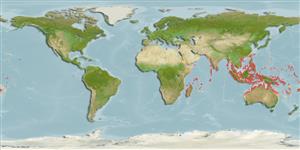Common names from other countries
Classification / Names / Names
ماع يماسا | فدارتم | Catalog of Fishes (gen., sp.) | ITIS | CoL | WoRMS
Environment: milieu / climate zone / depth range / distribution range
يسانش موب
; روش بل; قمع تارييغت 0 - 22 m (Ref. 100692). Tropical; 26°N - 36°S, 24°E - 167°W
Indo-Pacific.
Length at first maturity / Size / Weight / نس
Maturity: Lm ? range ? - ? cm
Depth range is based on occurrence in Papua New Guinea (Ref. 100692); to be replaced with a better reference. It is found on the upper foliage and trunk (Ref. 112937) of mangroves R. apiculata, R. mucronata, A. alba, A. marina, S. griffithii, S. alba, L. racemosa, C. decandra, C. tagal, B. cylindrical, X. granatum, A. rontundifolia and the palm Nypa fruticans (Ref. 110211).
Life cycle and mating behavior
غولب | لثم دیلوت | یزیر مخت | اه مخت | Fecundity | )ورال ( دازوت
Members of the order Neotaenioglossa are mostly gonochoric and broadcast spawners. Life cycle: Embryos develop into planktonic trocophore larvae and later into juvenile veligers before becoming fully grown adults.
یلصا ذخآم
عجارم | هدننك گنهامه | ناراكمه
Smith, B.D. 2003. (Ref. 3116)
NCUI زمرق تسرهف رد تيعضو (Ref. 130435)
ستياس رظن زا تيعضو (Ref. 108899)
Not Evaluated
Not Evaluated
اه ناسنا یارب رطخ
Harmless
یناسنا هدافتسا
| FishSource |
اهرازبا
رتشيب تاعالطا
Age/Size
دشر
نزو - لوط
لوط - لوط
يسانش تخير
)ورال ( دازوت
يناوارف
يتنرتنيا عبانم
Estimates based on models
Preferred temperature
(Ref.
115969): 26.7 - 29.3, mean 28.7 (based on 2431 cells).
